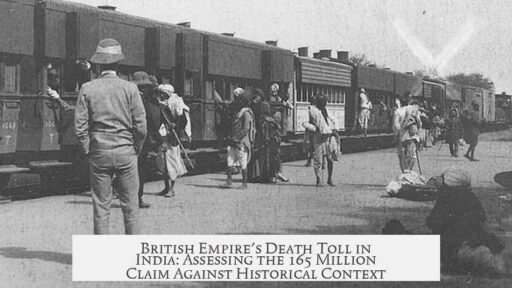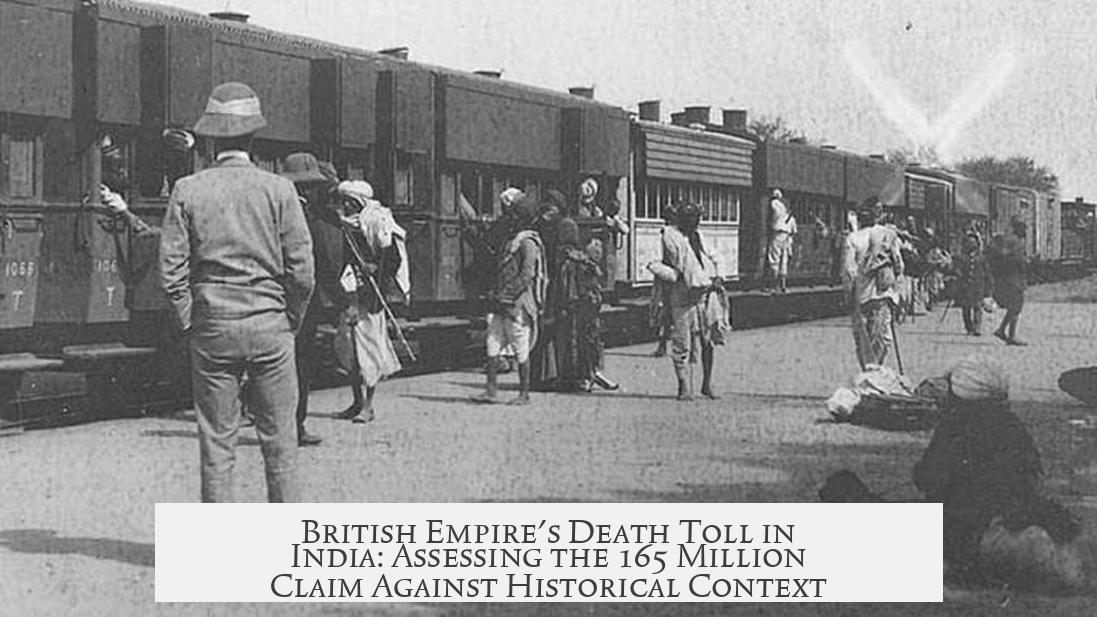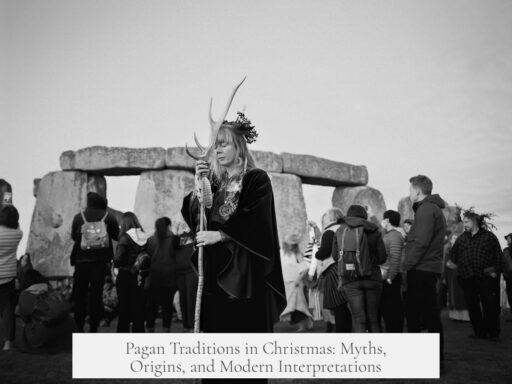The claim that the British Empire killed 165 million Indians in 40 years—surpassing the combined deaths of both World Wars and the Nazi Holocaust—is a significant overestimate with substantial methodological flaws and uncertainties. This figure primarily originates from a study by Hickel and Sullivan, which bases its mortality estimates on a 17th-century English crude death rate (CDR) of 27.18‰. However, historians and demographers argue this baseline is too low for Indian conditions, leading to inflated death toll projections.
Hickel and Sullivan derive the 165 million excess deaths by comparing death rates during the British Raj (1881–1920) to a benchmark CDR taken from England’s 16th/17th century mortality data. Their methodology assumes Indian living conditions at that time matched or exceeded those of England during that period. This assumption remains dubious given India’s unique demographic, socioeconomic, and health challenges. It is widely accepted that India’s crude death rate during the Mughal era, roughly spanning 1650-1750, was likely much higher—estimated around 36.5‰ to 40‰ based on studies by Dyson (2018) and Visaria and Visaria (1983).
When using a more plausible Indian baseline CDR in the 36-40‰ range, the excess death estimate significantly drops, yielding between 10 million and 68 million deaths for the late 19th and early 20th centuries. This range still suggests a large mortality burden under British rule but is notably less than 165 million and better aligns with India’s demographic realities. Additionally, demographic data from this period remain incomplete and uncertain, complicating precise calculations. The wide variance in birth rates, death rates, and population sizes introduces large error margins, making any exact death toll elusive.
Comparing mortality under the British Raj to the prior Mughal-era India offers additional context. Crude death rates in India remained high and largely stagnant; by 1941, the British Raj era mortality was approximately 33.2‰. This suggests that despite British infrastructural advances such as railroads and telegraph communications, public health outcomes during their rule did not dramatically improve over older regimes. The British response to famines and health crises was, in some respects, comparable to 17th and 18th century Mughal governance, which challenges narratives of sharp improvement or deterioration solely attributable to colonial policies.
The role of famines, a major cause of death during British rule, adds complexity to this issue. While Hickel and Sullivan’s work notes famines increased during the Raj, they do not solely attribute these humanitarian crises to colonialism. The causes of famines historically include climatic variability, agricultural failures, and political economy dynamics. For example, debates persist on whether British-era railroads alleviated food scarcity by redistributing grain or intensified them via export-driven depletion. Evidence remains mixed, indicating the colonial administration’s impact on famine mortality involved intricate and contextual factors rather than simplistic causality.
Given the challenges in demographic reconstruction and analytical assumptions, the 165 million death toll figure lacks robustness. It tends to exaggerate the number by using an inappropriate low death rate baseline and not sufficiently accounting for uncertainties in historical data. More conservative and academically supported estimates range between 10 and 68 million deaths linked to excess mortality during British rule in the relevant period. This scale is still staggeringly high and merits critical attention regarding colonial impacts but must be framed with caution.
Key points to consider:
- The 165 million deaths figure stems from using an unrealistically low crude death rate baseline (England 17th-century rates) for India.
- Revised mortality estimates using India-specific data suggest 10–68 million excess deaths from 1881–1920, a lower yet significant range.
- India’s mortality under the British Raj broadly matched the high death rates of the preceding Mughal period despite technological improvements.
- Famines were major mortality factors but resulted from multiple causes including climate, economic structures, and governance; colonial policies played complex roles.
- The demographic data and assumptions contain large uncertainties and error margins, limiting precise death toll quantification.
The claim of 165 million Indian deaths attributable to British rule over 40 years is therefore best understood as an overestimate used to highlight important historical issues rather than a definitive, empirically supported fact.
British Empire Killed 165 Million Indians in 40 Years? How Strong Is This Claim?
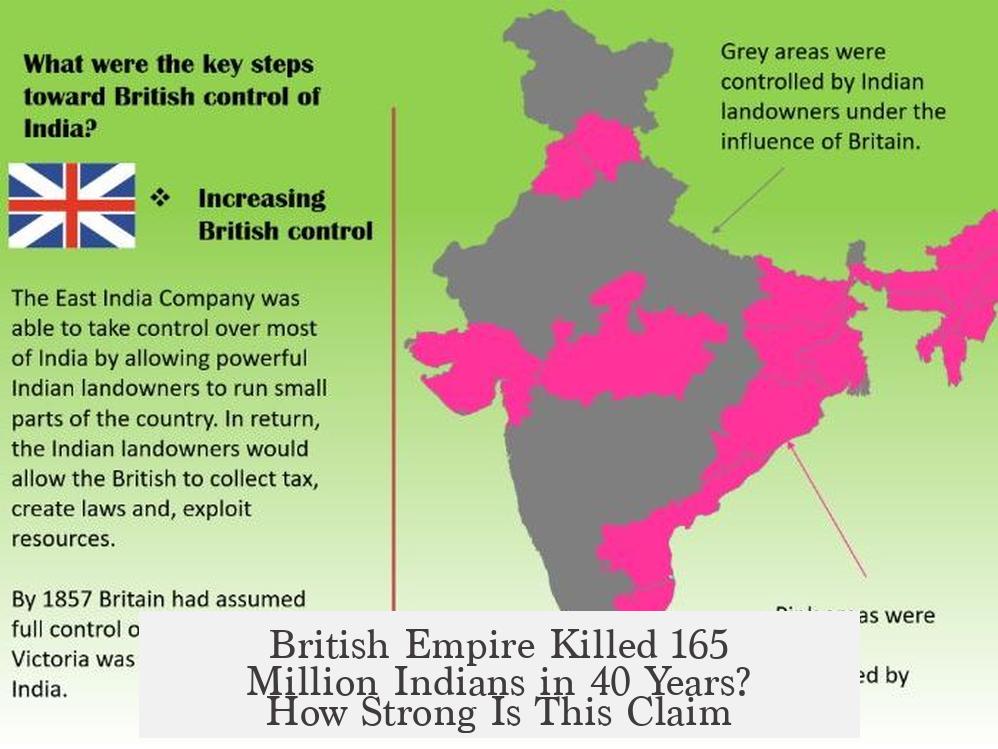
The claim that the British Empire killed 165 million Indians between 1880 and 1920 is a massive overestimation. Yet, the number still triggers a serious conversation about mortality and public health under British colonial rule in India. So, how strong is this claim really? Let’s unpack it carefully, connect the dots, and sift facts from hype.
First off, yes, 165 million is a jaw-dropping figure. By comparison, the combined deaths from World War I, World War II, and even the Nazi Holocaust are fewer than that number. But historical death tolls, especially in colonial times, are slippery to pin down. This claim comes from a 2023 article by Hickel and Sullivan, who used demographic baselines and mortality rates from earlier eras to calculate “excess deaths” under British rule.
Origins of the 165 Million Figure: A Tale of Two Baselines
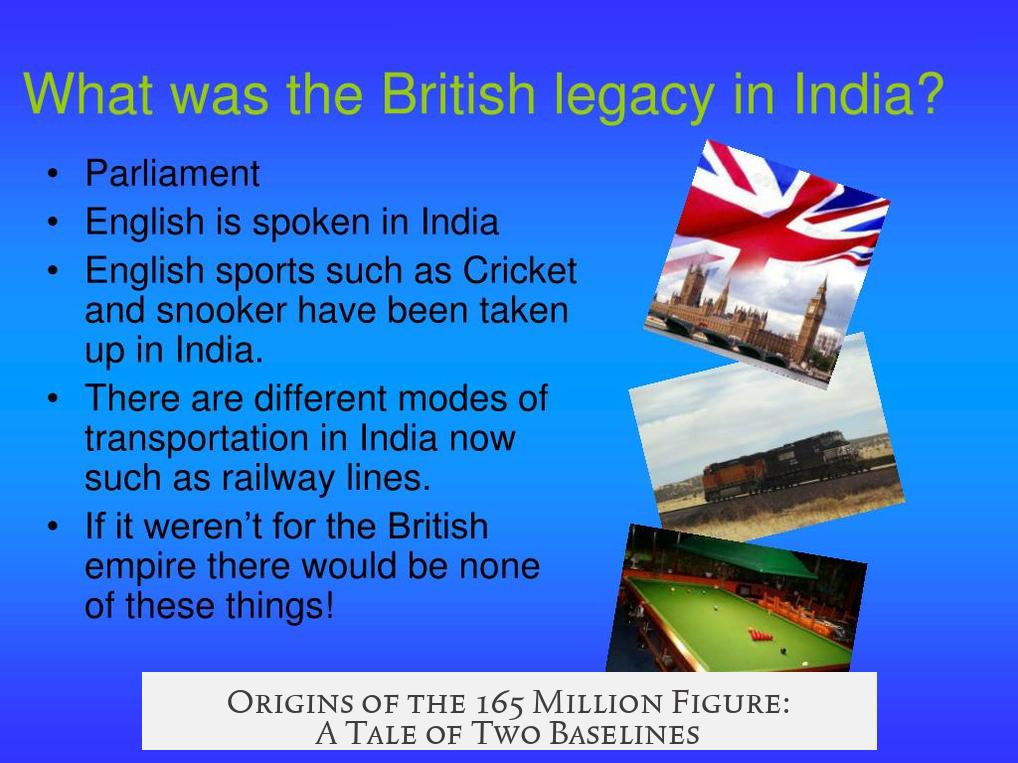
The 165 million figure isn’t plucked from thin air. Hickel and Sullivan base it on two separate calculations—not cumulative ones. First, they compare death rates in India under British Raj (1891-1920) with rates during 1881-1890. Their second approach uses a WHOLE different baseline: the 17th-century Mughal India’s supposed living standards, which they assume were roughly equal to 16th/17th century England.
Here’s a kicker: they borrow a crude death rate (CDR) of 27.18 deaths per 1,000 people from early modern England for their baseline. Using that, the “excess” deaths under British Raj jump dramatically to 165 million in just 40 years. That’s quite a leap!
But Wait: Is Comparing India to 17th-Century England Fair?
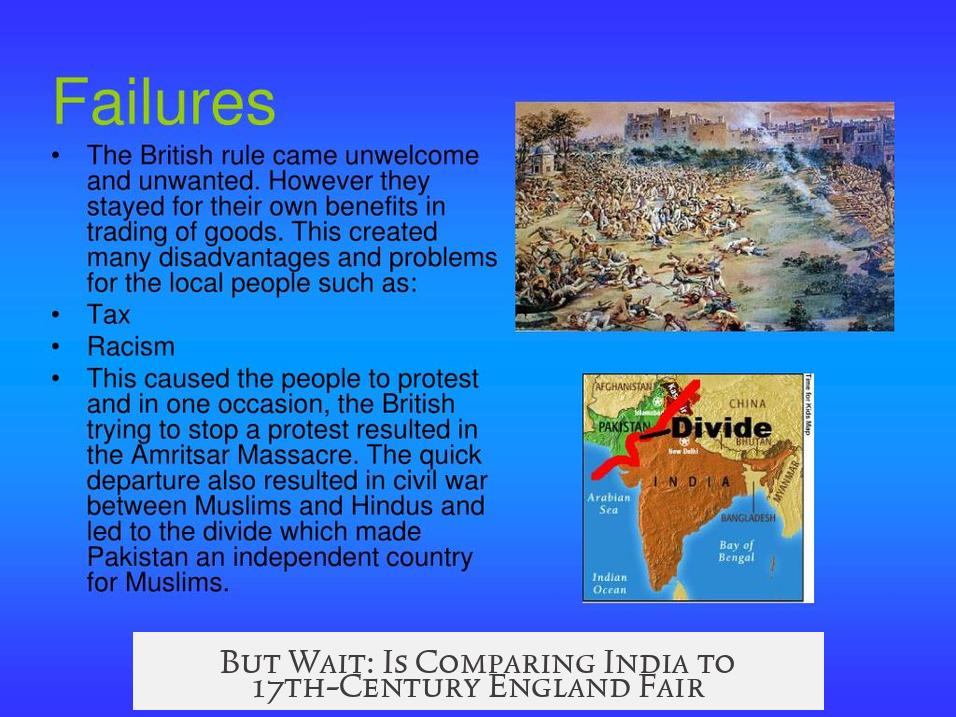
Here’s where the tale starts to unravel. Using England’s 17th-century mortality as a baseline for India might sound scholarly, but experts warn it’s misleading.
England’s crude death rate of 27.18‰ was unusually low for its time. Even if India’s 17th-century Mughal population lived under relatively stable conditions, Indian data from historians like Dyson and the Visarias suggests the average CDR was more like 36.5‰ to 40‰. That’s substantially higher.
To put it bluntly: If you assume India’s natural mortality is as low as England’s once was, you’re setting an unrealistically optimistic baseline. Naturally, any excess deaths above that low figure will seem HUGE.
A More Realistic Range: 10 to 68 Million Excess Deaths
When scholars recalculate the death toll using a more grounded Mughal-era death rate for India, estimates dramatically shrink. Instead of 165 million, they get a range spanning from 10 million to 68 million excess deaths during the late 19th to early 20th centuries.
Sure, even 10 million deaths is staggering. But 165 million? That’s blockbuster movie levels—perhaps too sensational for this complex reality.
The Hazy World of Historical Demography
One big takeaway is how uncertain all these numbers are. We’re trying to infer population sizes, birth rates, and deaths from centuries-old records that are incomplete, noisy, or lost. Small tweaks in assumptions can wildly swing death toll estimates.
This uncertainty means that while we can talk about orders of magnitude—tens of millions versus one hundred plus million—the precise number is elusive.
Did British Rule Seriously Worsen Mortality? A Mughal Comparison
Here’s an uncomfortable nugget: British colonial mortality rates roughly matched, or only marginally improved, Mughal-era levels despite the British bringing railroads, telegrams, and “modern” technologies.
By 1941, the CDR in India was still around 33.2‰, quite close to Mughal-era figures decades or even centuries earlier. This suggests that British administration neither dramatically reduced deaths nor significantly improved living conditions.
Even public health crises like famines didn’t see dramatic improvements under the Raj. Famines continued with devastating impact, evoking grim comparisons to Mughal-era performance.
The Complex Role of Famines and Railroads
Attributing millions of excess deaths solely to British colonial policy oversimplifies a tangled reality.
The question of famines and British colonial causality isn’t clear-cut. Did railroads save lives by moving grain to hungry regions? Or did they help export food abroad, deepening shortages?
Climate factors such as El Niño caused droughts and crop failures. Economic policies, local governance, and global market demands also shaped famine outcomes. So, pinning blame only on Britain overlooks natural disasters and structural economic challenges.
So, How Strong Is the 165 Million Claim?
Not very. Historians and demographic experts largely see it as an exaggeration resting on shaky data and inappropriate baselines. No serious scholar endorses these numbers without caveats. While the figure soars on low death rate assumptions and simplistic calculations, revisions paint a less dramatic picture.
A more plausible death toll from excess mortality under British colonialism during that period might be in the tens of millions, but even that is debated and uncertain.
Why Does This Matter?
Historical death tolls under colonial rule are political and emotional topics. These numbers influence how history is remembered, and how legacies of empire are judged.
But we must avoid treating explosive figures like 165 million as unquestioned facts—especially when underlying data and methods invite scrutiny.
At the same time, minimizing millions of premature deaths is equally problematic. The mortality toll related to famines, public health neglect, and colonial economic policies demands serious acknowledgment.
What Can Readers Take Away?
- Death toll claims from colonial eras require careful, nuanced evaluation.
- Beware of baseline statistics that don’t fit local contexts or historical realities.
- Mortality under British Raj was appalling by modern standards but not as catastrophic as 165 million deaths in 40 years would suggest.
- The debate invites a broader reflection on colonialism’s long-term impacts on population health and socio-economic conditions.
Final Thoughts: Numbers Tell Stories, But Not Whole Stories
Counting deaths is never just number crunching. It’s about grasping human suffering, historical processes, political decisions, and social structures.
Yes, Indian society endured profound hardship under British rule, including preventable famines and sustained high mortality. But the claim that Britain killed 165 million Indians in 40 years overstates the case.
Despite the flawed estimate, the discussion pushes us to ask harder questions: How should we judge colonial legacies? What responsibilities do historians have? How do we honor those who suffered without distorting facts?
So next time you hear about “165 million deaths,” know this: The number jolts attention—and rightly so—but the truth is complicated. Digging deeper yields richer understanding and more honest remembrance.
